Mexican dwarf crayfish (Cambarellus patzcuarensis) is one of the few crayfish you can keep in a community tank. Why? Because all crayfish are “silent killers”, “cutters” and diggers. They cut tank plants, dig all around the tank bottom and kill fishes. However, mexican dwarf crayfish is not like this, but for one simple reason – it is a very small creature.
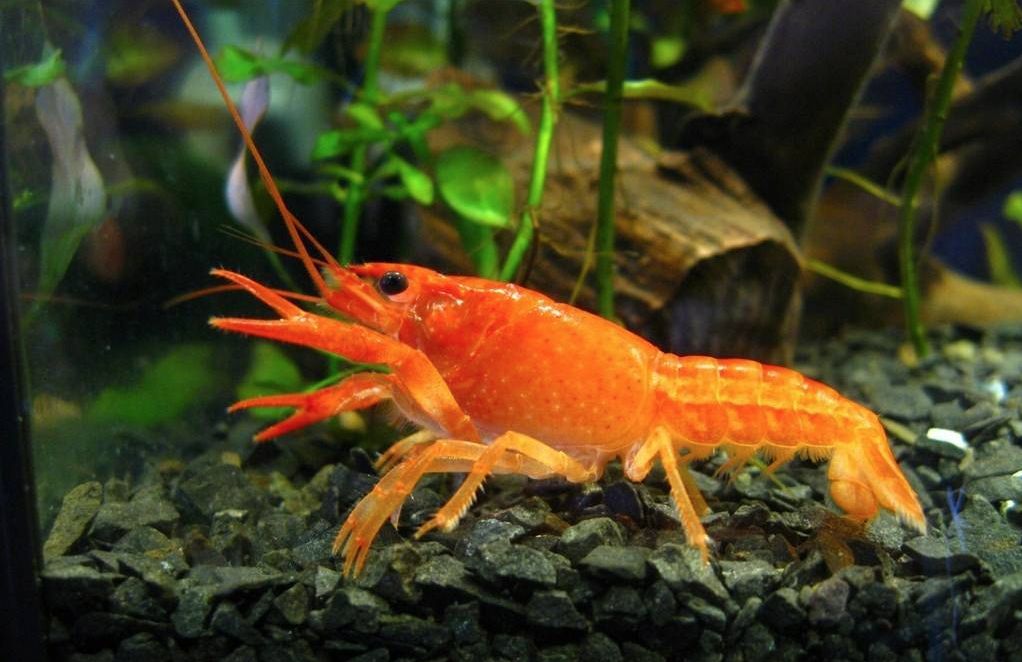
Contents
Habitation in the wild
Mexican dwarf crayfish is from Cambaridae family, Cambarellus species and is often kept as an aquarium pet due to its small size and attractive coloration. They comes both from Mexico and the USA. Basically it dwells in streams and small rivers, though it can be also encountered in ponds and lakes. It prefers places with slow water flow or standing bodies of water. They prefer slow-moving or still waters with vegetation, rocks, and hiding places. They are well adapted to live in various water conditions and can tolerate a wide range of temperatures and pH levels.
Mexican dwarf crayfish are bottom-dwellers, spending much of their time scavenging for food and exploring their surroundings. They feed on a variety of food sources, including algae, aquatic plants, small invertebrates, and organic detritus. They play an important role in their ecosystem by helping to break down and recycle organic matter.
In their natural habitat, Mexican dwarf crayfish engage in various behaviors, such as foraging, burrowing, and defending their territories. They are known to be territorial and may display aggression towards conspecifics (other crayfish of the same species) during breeding or when competing for resources.
Description
Mexican dwarf crayfish typically reach a maximum size of about 2.5 to 3 inches (6.4 to 7.6 centimeters) in length. Males and females are similar in size, with males often being slightly larger.
The lifespan is about 2 years. However, there is some information that these species can live longer. Proper care and maintenance of the crayfish’s habitat are crucial in promoting a healthy and long lifespan.
The body is covered with strong chitinous carapace of bright orange or even red color, due to which Patzcuaro got its name. The division between large cephalothorax and pleon is very pronounced. This crayfish has 19 pairs of limbs and all of them has their own tasks.
It has 5 pairs of ambulatory legs which gave the name to the unit. However, the first pair is quite indirectly connected with walking, since these are chelae which we all know well. They serve as an additional rest for a mexican dwarf crayfish, help it to collect food from the bottom, to attack others and to protect itself.
It uses antennas and antennules to navigate. It also has 3 pairs of maxilliped limbs to carry the food to its mouth. The chelae can be only technically considered as maxilliped: the crayfish doesn’t use them to walk, but the second pair of its ambulatory legs has small chelae as well.
There are 4 pairs of setireme on the crayfish pleon and two pairs of uropods and telson on its tail. He walk along the bottom by means of its legs, but in case of emergency it abruptly bends it pleon together with telson and moves backwards very fast.
We should mention that at that its path of motion is unpredictable, which means that it is not that easy to catch a dwarf crayfish in a tank.
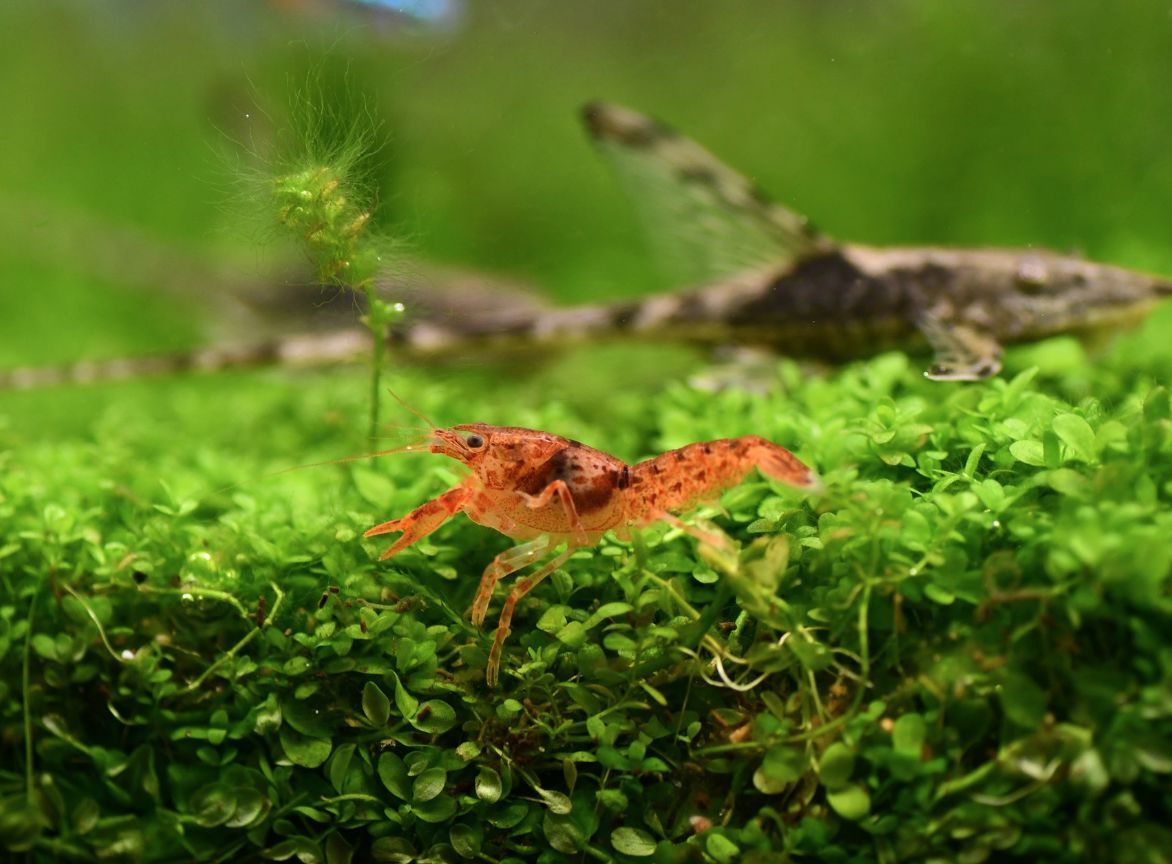
| Characteristic | Description |
|---|---|
| Scientific Name | Cambarellus patzcuarensis |
| Common Name | Mexican Dwarf Crayfish, dwarf crayfish; mexican dwarf lobster; orange crayfish; mexican dwarf lobster |
| Size | Up to approximately 3 inches (7.5 cm) in length |
| Coloration | Typically reddish or orange-brown with blue or white highlights on claws and carapace |
| Habitat | Freshwater streams, rivers, lakes, and marshes in Mexico |
| Preferred Water Conditions | Slow-moving or still waters with vegetation and cover |
| Temperament | Generally peaceful, but can be territorial towards conspecifics |
| Diet | Omnivorous, feeding on algae, aquatic plants, small invertebrates, and organic detritus |
| Compatibility | Can be kept with small, non-aggressive fish species |
| Aquarium Requirements | Minimum tank size of 10 gallons (38 liters), ample hiding places, and appropriate structures (rocks, caves, plants) |
| Water Parameters | Temperature: 70-80°F (21-27°C); pH: Neutral to slightly alkaline |
| Breeding | Females carry fertilized eggs under their abdomen until hatching; young remain attached to the mother for a period of time before dispersing |
| Adaptability | Can tolerate a range of environmental conditions |
Keeping in a tank
Tank size
Despite its small size this is a territory dependent creature. The recommended tank size for Mexican dwarf crayfish (Cambarellus patzcuarensis) depends on the number of crayfish you plan to keep and the amount of space you want to provide for them. As a general guideline, a minimum tank size of 10 gallons (38 liters) is typically suggested for a pair or small group of Mexican dwarf crayfish. To avoid undesirable rivalry it’s better not to keep more than four species in a tank of 100 liters capacity. By providing an adequately sized tank, you can create a comfortable and stimulating environment for Mexican dwarf crayfish to thrive.
A larger tank is always beneficial as it provides more swimming space, ample hiding places, and helps maintain better water quality. If you plan to keep more than a couple of crayfish or want to incorporate other tank inhabitants, a larger aquarium will be necessary to accommodate their needs.
Tank decor
Additionally, it’s essential to provide suitable hiding places, such as rocks, caves, or plants, to mimic their natural habitat and offer them places to retreat and feel secure. The tank bottom can contain any shelters – tank plants, snags, stones and others – the more, the better.
The thing is that mexican dwarf crayfish need places to hide, which is especially important when he is shedding and becomes totally helpless or for their females when they are carrying eggs. Anything will do as a shelter. It can hide right under a tank plant leave, in a snag crack, under a sprayer or between stones.
We’d also like to mention that it’s very seldom that you see a mexican dwarf crayfish walking around the tank bottom. They are good at hiding. Sometimes you may not see them for the whole day and sometimes they all come out in the evening.
It is quite possible that mexican dwarf crayfish are more active in the evening and night hours. So, you shouldn’t bother if you haven’t seen your crayfish for several days, especially if there are a lot of places to hide in your tank.
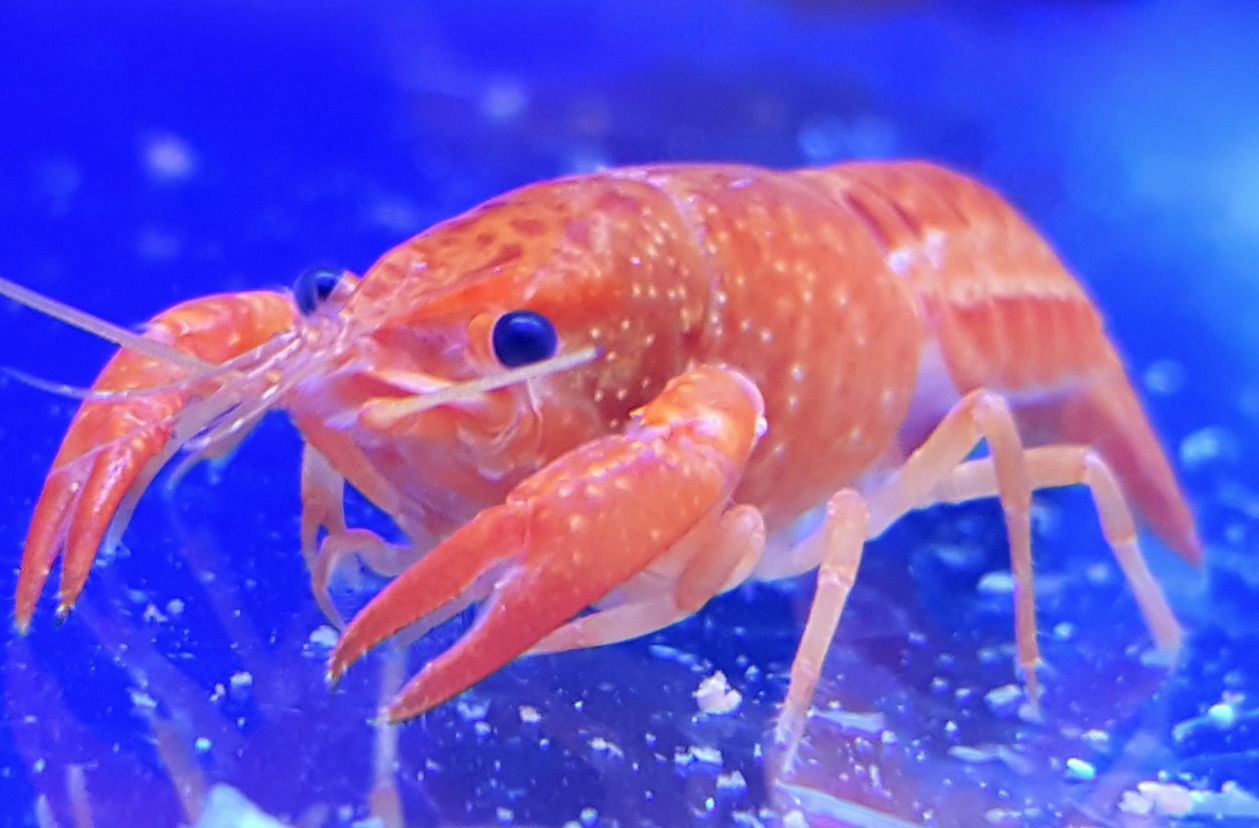
Water parameters
Mexican dwarf crayfish prefer a temperature range of 70-80°F (21-27°C). Optimal water temperature is 80 – 83 °F (25 – 27 °C). Mexican dwarf crayfish can tolerate a relatively wide range of pH levels, but neutral to slightly alkaline conditions are generally recommended. Tank water pH should be equal to 7 and higher, optimal pH value is 7,5-8. Crayfish sheds its skin from time to time and to grow a new exoskeleton it needs calcium. Correspondingly, carbonate hardness of the tank water (kH) should be equal at least 6.
Can live in soft and acidic water, though not for a long time. If tap water in your area has such parameters and you are going to keep crayfish in a tank, you can settle the matter by putting a piece of limestone or some coral chips on the tank bottom.
These creatures are extremely sensitive to ammonia and nitrites, that’s why it’s not a good idea to put them into a brand new filled tank. It’s crucial to keep ammonia and nitrite levels at zero, as these substances are toxic to crayfish. Regular water testing and proper filtration are necessary to ensure a safe environment. Nitrate levels should be kept low, ideally below 20 ppm (parts per million), to prevent long-term stress on the crayfish.
Another crucial parameter is an amount of oxygen in the tank water. From all mentioned above we can conclude that good filtration and aeration are important as well as weekly water renew.
Firstly, by doing this we decrease nitrates amount in the tank water; secondly, usually mexican dwarf crayfish shed their skin and mate when the water is renewed. As a rule, in 2-3 days after tank water renew your crayfish sheds its skin. Also you shouldn’t use any copper containing chemicals – it is very harmful for any crayfish.
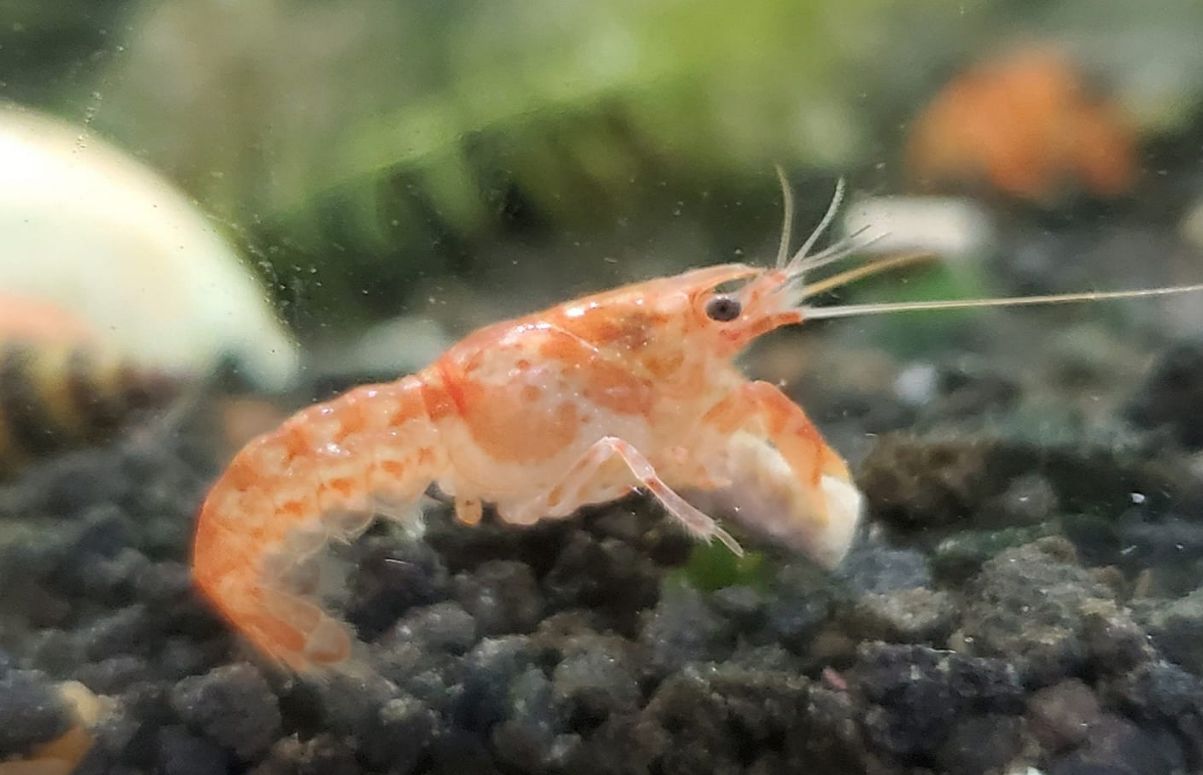
Tank mates
Can one keep mexican dwarf crayfish in a community tank together with other fishes? Yes, you can. But you should bare in mind several peculiarities. The mexican dwarf crayfish itself isn’t large. Its chelae are small and it can hardly hurt anyone with them. The scariest thing this crayfish can do, is put up his chelae viciously, but as a rule, it runs away at any sign of danger.
Species such as small tetras (e.g., Neon tetras, Ember tetras), rasboras (e.g., Harlequin rasboras, phoenix rasboras), and small livebearers (e.g., Endler’s livebearers, guppies) can often be kept with Mexican dwarf crayfish. These fish should be small enough to not pose a threat to the crayfish and have peaceful temperaments.
Since crayfish prefer water pH value higher than 7, then platy, molly can be perfect tank mates as well as other fishes that feel comfortable at pH about 7,5. There shouldn’t be any large and aggressive cichlids in the tank, because they’ll just eat any crayfish in it. Therefore you can see that the range of tank mates is quite wide.
Mexican dwarf crayfish should not be kept with large, aggressive fish species as they may be seen as potential prey or may harass the crayfish. The crayfish’s small size and relatively peaceful nature make them vulnerable to larger, predatory fish.
Large fish species that are known for their aggressive behavior or have a tendency to nip at other tank mates should be avoided. Examples of fish that are not suitable tank mates for Mexican dwarf crayfish include cichlids (such as Oscars or Jack Dempseys), large predatory catfish (such as Redtail Catfish), aggressive barbs (such as Tiger Barbs or Tinfoil Barbs).
Non-aggressive dwarf shrimp species, like Cherry shrimp (Neocaridina davidi) or Amano shrimp (Caridina multidentata), can generally be kept with Mexican dwarf crayfish. However, there is a slight risk that the crayfish may prey on smaller shrimp, so it’s important to provide plenty of hiding places and observe their behavior closely.
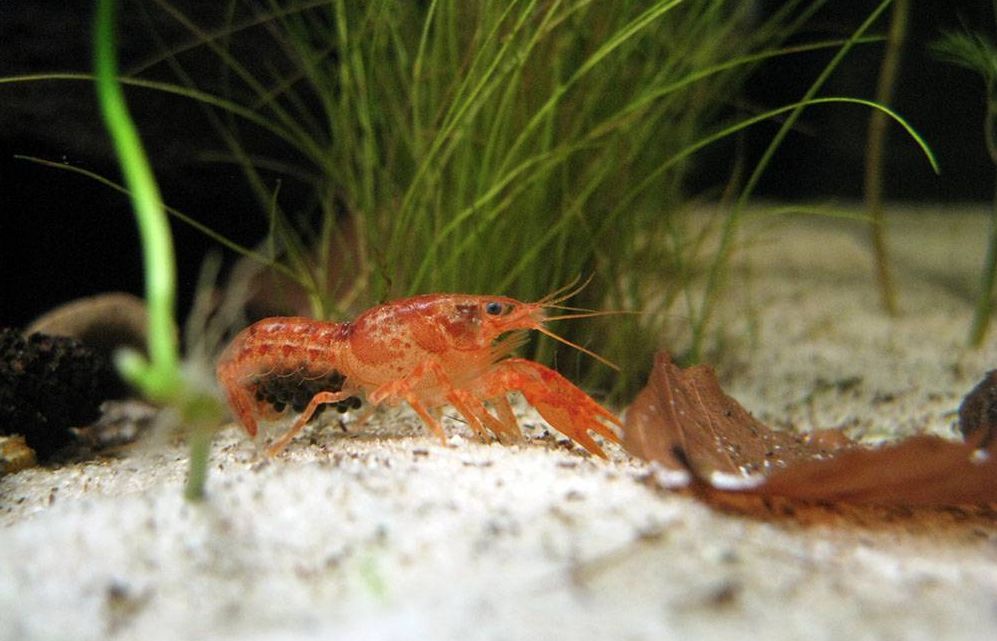
Feeding
Dwarf mexican crayfish feeds on any organics, for example, tank plant remnants. Things are even easier if you keep crayfish in a community tank. Any fish food will do for them. The main thing is that this food gets to the tank bottom.
Tablets and pellets for catfish are the best in this case. High-quality, sinking pellets formulated specifically for crayfish can serve as the primary staple food. These pellets typically contain a balanced mix of proteins, carbohydrates, and essential nutrients. Offer them in appropriate portion sizes, taking care not to overfeed.
Bloodworm and brine shrimp will also do. Supplement the diet with protein-rich foods to meet the crayfish’s nutritional requirements. Suitable options include frozen or live foods like bloodworms, brine shrimp, daphnia, and small insect larvae. These can be offered as occasional treats or as a regular part of the diet.
If you want, you can feed with some delicacy, such as a piece of cucumber, squash, carrot. Include blanched vegetables in the diet to provide essential fiber and nutrients. Suitable options include spinach, zucchini, cucumber, and peas. Blanching vegetables involves briefly boiling or steaming them until they become softer and easier for the crayfish to consume.
Don’t forget that crayfish is a scavenger. So, what if some fish dies while you are away? Here comes a crayfish! They will eat its body in a very short time and won’t let is rot and spoil the tank water.
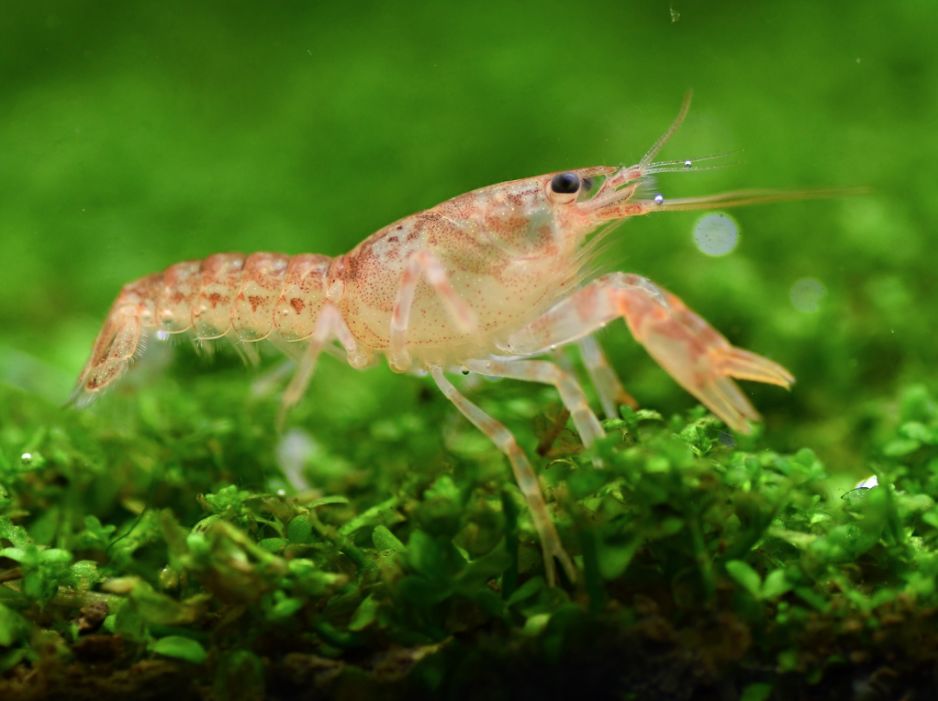
Shedding
All crustaceans shed their skin from time to time and dwarf crayfish isn’t an exception in this respect. Replacing its old exoskeleton with a new one is the only way for a crayfish to grow. Juveniles shed their skin rather often – once in 7-10 days.
Adult species shed more seldom. It is crucial for a crayfish to have a place to hide while shedding. The crayfish stays in its shelter till its new chitinous carapace hardens. A crayfish without its carapace is completely helpless. Besides, shedding is the only way for it to grow its lost limbs.
Crayfish loose their legs under various circumstances. Very often their chelae suffer the most, since they are its largest limbs. It can get stuck somewhere, considering where crayfish like hiding.
Also they may loose their limbs just when shedding – if the mexican dwarf crayfish can’t take it out from its old carapace, it just cuts or bites it off. In both cases this is called autotomy. However, it is a very rare thing when crayfish harms one of its kind, not to mention killing one while fighting (since fights happen sometimes).
So, if you have seen a mexican dwarf crayfish with one chela – don’t worry, a new one will grow soon, during the next shedding period. As well as living with one chela will not affect its quality of life in any way.
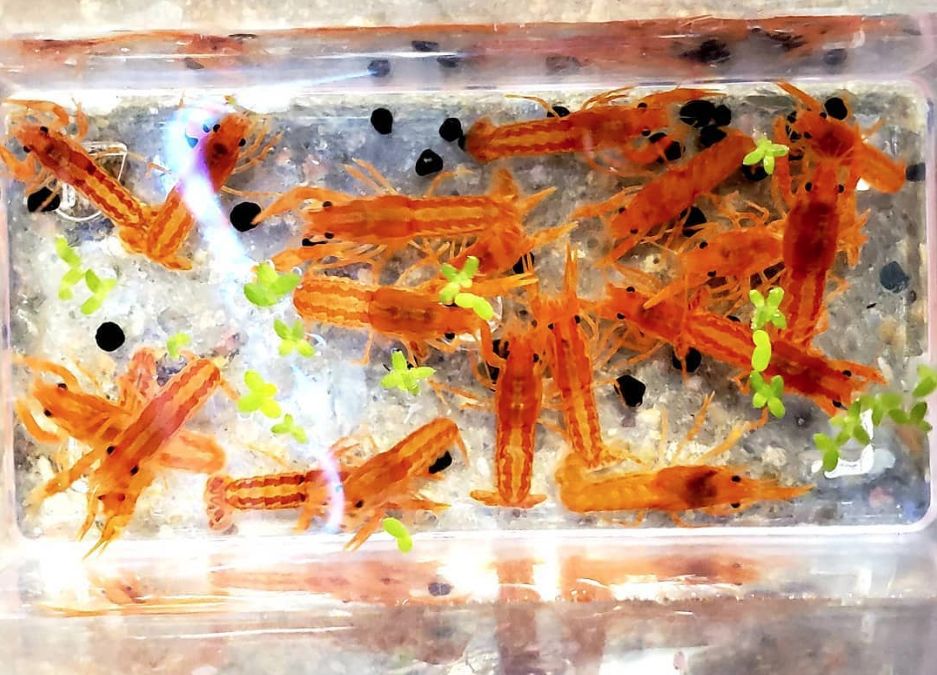
Gender differences: male vs female
Crayfish are diclinous species. Male are smaller than female. They have strong chelae and a copulatory organ (a modified pair of limbs) on their abdomen.

Breeding
Mexican dwarf crayfish lifespan isn’t long, it equals about 1.5-2 years. Therefore if you like crayfish, you’ll have to become aware of their breeding process. Breeding as a rule occurs without any participation of the aquarist except the cases when crayfish are kept in a community tank.
Juveniles are small and they shed their skin very often. So, even if their tank mates are the most peaceful fish you can find, they still have no chances to survive. Mating occurs right after the shedding process. After this you will see eggs on the abdomen of female.
The eggs are quite large, not transparent and they are easily seen. But the problem here is that the female tries not to leave her shelter without any necessity. That’s why if it’s not a crayfish species tank you have, it’s better to prepare a separate tank for juveniles.
You should keep in mind, that adult is indifferent both to its or anyone else’s offspring and at that they don’t take care about their juveniles either.
Sources: